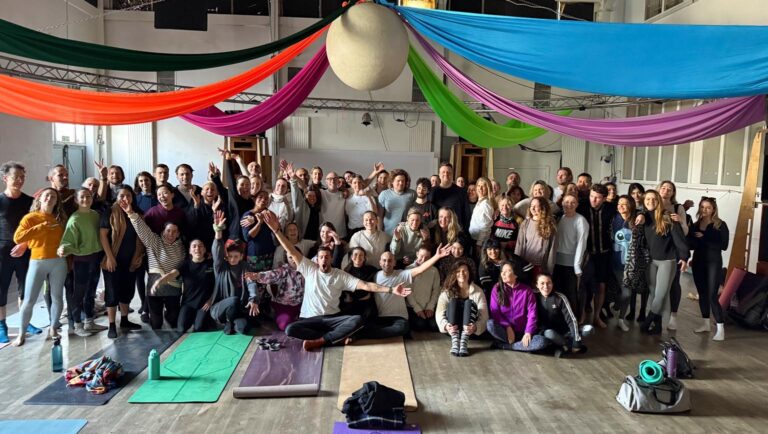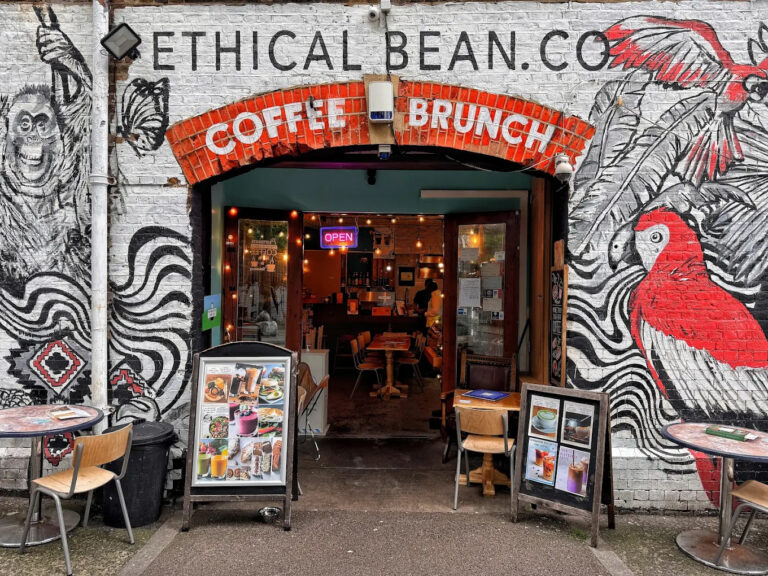
Review: Kokin – tuna meets fire at The Stratford
The new sushi restaurant now at the iconic skyscraper’s 7th floor and terrace
A rave history, by Simon Cole
With the recent publication of a history of 80s-90s raves, radio and record shops in Waltham Forest, new light has been shone on East London’s inchoate dance music scene. While the ‘Second Summer of Love’ thrust London’s West End and Manchester’s Hacienda into the national spotlight, things were also getting messy around East London.
There were clubs, legal and otherwise, throughout, from Dalston’s legandary sweatbox Four Aces to influential spots like Hoxton Square’s Blue Note, where Goldie’s regular Sunday nights played a key role in the birth of drum & bass. As these areas scrubbed up over time, things simply moved East, including the odd squat party on what’s now the Olympic Park site and all-nighters at places like EQ Warehouse.
The new landlord of infamous former squat party venue the Lord Napier, Rob Star, first happened across it during parties in the early 2000s. A raver since the early 90s, Star explains how he came to run something there himself:
“I knew the borders of Hackney Wick and Stratford were home to various legal and illegal venues. The Napier was fairly well established at the time and various parties were also going off in different artists studios. Looking for somewhere a bit bigger, I stumbled across the EQ Warehouse on Waterden Road. There was an amazing mirrored tunnel entrance, a huge main room with the DJ booth taking centre stage, dance platforms on either side and two large bars.”
The area was still a bit of a secret then, as he explains: “In those days people who lived over in Shoreditch had never even heard of Hackney Wick, never mind knew where it was. So we used to run buses to make sure our punters made it. People used to love the fact that they didn’t have a clue where they were going.” Another veteran told me about a first-time promoter losing his takings in a robbery at an undisclosed venue where Security claimed not to have seen anything. It was a fairly lawless time.

In the early noughties Hackney Wick was a relatively unknown destination, but the clued-in and the locals knew to head to places like the Napier. Amanda Dackombe now runs the Faversham Literary Festival but has fond memories: “I remember the Napier as an old squat with floor to ceiling columns, very industrial-looking: graffiti, muck and smoke with an old piano. It always seemed like the middle of nowhere – like it was the last place still standing in the Wick. We partied with Courier DJs with bags of vinyl on the backs of their bikes. I can remember a mass of cyclists skimming through Hackney in the early hours. OCB parties were mayhem: squatters; radicals; dancing tribes.” Those tribes sometimes met in nearby woodland or on boats on the Hackney Cut. But across East London, warehouses were a party staple with their DIY culture. Occasionally they tiptoed across a legal line by selling alcohol: sometimes to cover DJ/equipment costs; to raise funds for art projects and festivals; or even pay fines or rent.
Back in the world of official venues, mention of Shapes on Wallis Road brings smiles to faces. Like Passing Clouds, it prided itself on diverse guest artists and there was even the Moving Shapes spin-off, an arts-themed CIC (Community Interest Company). Old flyers show established artists like Kae Tempest and Beans On Toast raising money for refugees while youth songwriters and drum circles also appeared.
“Our focus was the transformative and unifying power of music and culture, “says the venue’s founder, Seb Glover. “Born during an era of major Tory public sector cuts, emphasis was placed on community-building initiatives and an extra weighty sound system. Shapes’ rawness as a space and the diversity of the Shapes family was a reflection of its authenticity. It became home to so many visionaries, radicals and pioneers, both in our studios and on our dancefloors.”

Not everyone partied hard though; I remember encountering one visitor who stayed completely straight to gleen inspiration from the Shapes vibe for their own venue.
Now a climbing centre, its exterior is easily recognised by street art by Berlin Wall legend Thierry Noir. Shapes closed in controversial circumstances in 2016, with Glover left feeling that the authorities were simply not keen on late-night club events taking place there any longer.
Closures often come with allegations of hidden agendas obscured by legal pretexts, Save Ridley Road being a recent example over in Dalston. Pre-Covid, Hackney was under fire from campaigners claiming that overly harsh restrictions on late night locations would kill the borough’s reputation. As today’s Hackney Wick has become a major nightlife destination for people traveling in from far and wide, ideas like copying Dalston’s late night wardens have come up. Over there, as people started to come from all over to the Kingsland High Street strip, complaints grew from local residents about noise and urine etc. There was talk of ‘lessons learned from Shoreditch’. But according to a Mayor of London 2017 report, since 2007 some 35% of grassroots music venues have closed. The remaining 94 contribute £92m to London’s economy with much of that being in the form of wages. It highlighted business rates as a major issue for the survivors and Hackney as a key borough. Recent nightlife casualties here include Passing Clouds and Dance Tunnel, but a shrinking late night offering is not unique to East London. Regulars at Lovebox Festival in Victoria Park might have heard LCD Soundsystem’s ‘New York I Love You’ played – lamenting an overly cleaned-up city that has lost some soul. Here in Europe, the squat culture that birthed so many artists and alternative culture innovators is disappearing from cities like London and Berlin, while London Night Czar Amy Lamé can be found in GQ Magazine admitting that property beats pints when it comes to profits.
Standing at the busy Hackney Wick Station, I hear a man who looks to be in his late 20s declare: “I’m too old for Hackney Wick now.” Meanwhile trains disgorge revellers bound for the new generation of official bars and clubs. By Main Yard, lines snake around street food vans and a young guy in a chest harness shivers in the burger queue as the breeze plays across his torso. And as the troupe of weekly stag and hen parties start to come, so rise the concerns of residents. There’s an established trope in Hackney of people moving next to nightspots and complaining about music noise. Signs have been seen in Shoreditch warning any potential property buyers how busy it is by night. The recent ‘Agent of Change’ legal principle is an attempt to address this phenomenon by putting the onus on the incomers to look at measures like soundproofing rather than trying to close venues down.
For now the Wick buzzes at the weekend. Various spaces are open until 3/4am with the likes of Queer electronic music festival Body Movements running a wildly-popular 16-venue event recently. In the long term, is a quiet residential neighbourhood inevitable as new arrivals tire of the sound of music? Or can some kind of compromise be reached in this brilliantly unique community? Cities are balancing acts, they never stand still. For now, the buzz may be preferable to lockdown silence, but if the nighttime economy continues to grow, there could be a crunch point looming on this part of a changing East London horizon.

Valuing the night, by Tom Kihl
When Covid shut down the possibility of going out after dark, it revealed a lot of hidden truths about the importance of the night. For the first time, we could feel what life would be like without the late shows, long meals, carefree dancing and wonderfully unpredictable socialising that thrives from 6pm-6am. Not only that, but we could see how the authorities’ traditional approach towards nightlife – as lowbrow hedonism to be regulated or banished, rather than the fire in the engine of our wider culture – was now placing it in mortal danger, as support packages failed to address the plight of many underground venues. Fortunately, the otherwise grim circumstances did seem to jolt the national discourse, which may in turn have a host of positive outcomes here in the Wick, too.
With culture at night finally being taken more seriously, tussles between residents and venues may – finally – be becoming more grown-up. “There was always a feeling in London that councils didn’t really want late night anything,” says Rob Star, who had a protracted battle to get an extra half hour, up to a hardly-wild 9.30pm, for the roof terrace of the Napier. “That includes people even sitting down eating outside, let alone drinking or dancing. But obviously, once you put this many residential houses into a densely packed area, it’s going to be difficult to live side-by-side with a thriving nighttime economy.” With more goodwill towards the sector after the hardships of Covid, and the temporary relaxing of regulations on outdoor table space to help social distancing, we might find the needle has shifted on some of the more draconian licencing in the long term. The case is certainly being argued louder than ever by trade bodies like the Night Time Industries Association, who’s CEO Mike Kill is now a mainstay of TV news. “It’s still hard to communicate our value politically,” he tells us, “and to advocate strongly for what we do as a sector, when you go to meetings with the Department of Culture, Media and Sport, and you’ve got ministers there who genuinely still think all nightclubs are like Saturday Night Fever.”
Someone who can attest to how much the whole industry has changed and professionalised over the years is Queen’s Yard’s head of security Bernard Reviere. “I remember when there was just Crate on its own here,” he says, “and the car park was full of local artists sitting on pallets with their drinks. Now when we speak to people they’ve come in from Essex, across from West London, all sorts. Hackney Wick is a lot more on the nightlife map, which brings in lots of good people, and also some bad ones, so our job has become hugely more complex.” The vital role of those who remain in the shadows, but without whom nightlife would not be possible – the door staff, production crew, emergency services, transport workers, cleaners and so many more – has also been brought into focus by the Covid shakedown. Just saving the venues is not going to be enough if there are not enough staff to open them. “We’ve lost a massive number of people in the security industry due to the pandemic,” says Bernard. “It’s got a lot tougher, and people aren’t sure if they want to carry on.”
With the role of security now so closely aligned with ensuring everyone’s safety, every minor incident is seen critically, and stories like the national furore over spiking incidents can quickly turn towards blaming door staff, who are in fact working harder than ever. Yet despite the unprecedented challenges of keeping the wheels on the local and national nightlife juggernaut, innovation, success, and most importantly joy, are all flooding back after the dark days of lockdown. “We’re seeing an increase in the quality of people coming out now,” says Antonio of Boat Live, the floating music venue that’s now based on dry land at Hackney Wick Underground. “The older crowd have realised again how much they enjoy going out listening to DJs, and the younger ones are really into coming and discovering music.” His daily programme of events includes parties, streaming sessions and chances for producers to come and hear their new music played on a club system for the first time, on the rig that was custom made as part of the boat build by local soundsystem heroes, Core. “I believe in the concept of smaller venues,” Antonio declares. “Our goal is to elevate as many artists as we can, and we can do this from a 75-person capacity venue fine these days. If we put on a local collective and stream them live on Facebook, suddenly the boat is packed.”
It reveals another unexpected outcome of lockdown; that streaming sets to people at home can be a key part of the real life club experience. Innovation will no doubt continue, and the Wick is naturally at the forefront. We’ve collectively awoken to the non-negotiable need for a night time economy and culture in the UK, so where better than here to try out new models of co-existence and collaboration, particularly now we know what everyone stands to lose if we just go to sleep.


The new sushi restaurant now at the iconic skyscraper’s 7th floor and terrace

Exploring the health advantages of belonging to something bigger than ourselves

Your timely reminder to go visit these amazing restaurants, bars and cafes this summer while we wait for better bridge access…
A joint venture in collaborative local media from:


In partnership with

Regulated by IMRESSS, the Independent Monitor for the Press CIC.
For more info on our complaints policy, or to make a complaint, visit FAQ.
